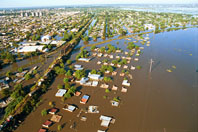|
Last Wednesday, April
30, most of Santa Fe province was hit by a water event of the utmost
emergency. Heavy rainfalls caused the Salado river to overflow as
its water volume increased and covered most of this Argentine region,
resulting in serious consequences in terms of the productive
activities in the basin of the Paraná and Uruguay rivers. From a
series of different declarations as to the origins of this
unprecedented catastrophe, we state those by Argentine scientists
who expressed that this situation is the result of the El Niño and/or
La Niña phenomenon, global warming and, above all, the lack of
prevention on the part of local authorities.
These floods have been
considered as the worst natural disaster in Argentina as there are
no historic precedents of this type. The overflow of the Salado
river covered more than half of the city of Santa Fe, with 440.000
inhabitants, and affected 50 towns in seven different departments to
the centre-north of the province. The waters covered an extension of
approximately 40.000 square meters, corresponding to the third part
of the Santa Fe province (133.007 Km2 - 3.5% of the Argentine
territory).
The number of evacuees
varies from 50.000 to 100.000; while the dead will be officially
reported once waters recede. Despite the fact that the water level
is slightly down as a result of detonations in several embankments,
there are still some vicinities under water. Distribution of aid
resources is problematic; several areas still lack electricity and
the risk of collapse threatens many dwellings; in addition, health
problems are arising.
From the perspective
of agricultural activities -the source of productive wealth for this
region-the water saturation of the land has caused enormous loss,
mostly in the dairy sector, a relevant activity in this part of the
country.
Since 1978, the
National Water Institute of the Universidad del Litoral (UNL) has
been conducting hydrological studies in the Salado basin and has
presented proposals to Contingency Plans as well as other studies on
risk assessment and prevention of environmental disasters. (See
press release of UNL at: http://www.unl.edu.ar
and research work available at: http://fich.unl.edu.ar).
In the context of
these tragic events, EMS/IDRC wishes to extend solidarity to all
those affected by the Santa Fe floods in Argentina. In order to
contribute to improve the quality of life of urban populations and
to support the work of municipalities throughout Latin America to
prevent environmental disasters, the EMS is currently preparing a
Manual for the Environmental Management of Vulnerable Areas. This
manual is conceived as a tool in environmental planning of
vulnerable regions.
Source: assorted
Argentine means of information, Internet

Photos: El Litoral
|



